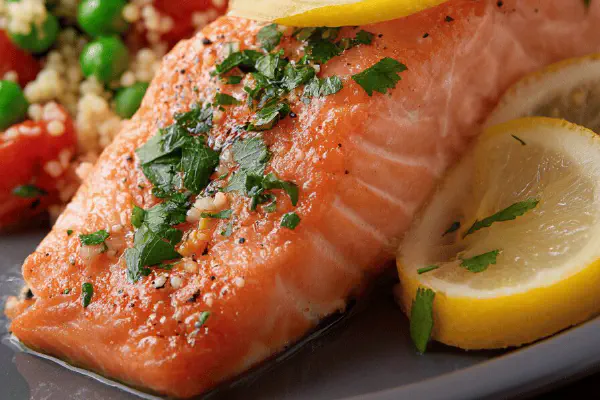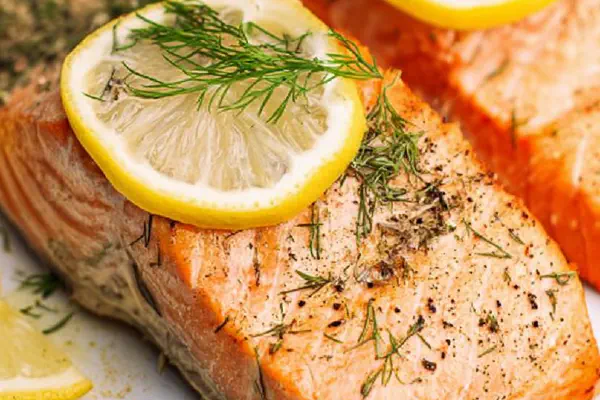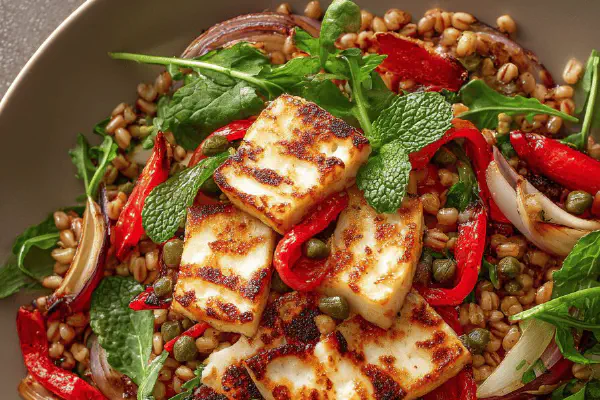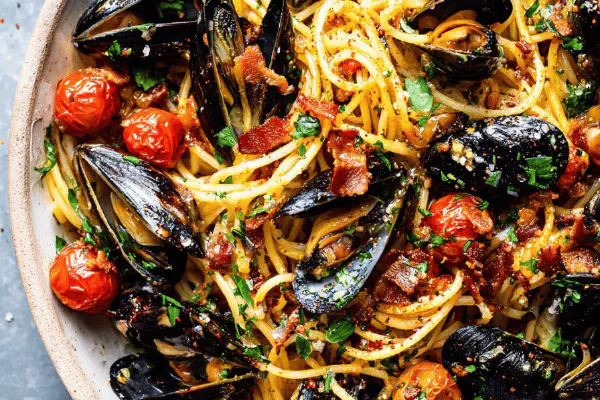Cold Salmon Taboulé Peas

By Emma
Certified Culinary Professional
Ingredients
Salmon
- 2 gousses d’ail hachées
- 45 ml huile d’olive
- 2 rondelles de citron
- 600 g filet de saumon avec peau, coupé en 4 pavés
Taboulé
- 150 ml eau
- 65 g boulgour fin
- 120 g tomates cerises coupées en quartiers
- 55 g persil frisé ciselé
- 25 ml menthe ciselée
- 40 ml jus de citron
- 1 pincée cumin moulu
- 1 pincée coriandre moulue
- 150 g petits pois surgelés, blanchis et refroidis
About the ingredients
Method
Taboulé
- 1. Porter l’eau à ébullition dans une casserole. Retirer immédiatement du feu, ajouter le boulgour, couvrir. Laisser gonfler 12 à 17 minutes. Aérer délicatement à la fourchette. Mettre de côté pour refroidir complètement.
- 2. Incorporer les tomates, persil, menthe, huile d’olive, jus de citron. Saupoudrer cumin et coriandre. Saler, poivrer. Mélanger avec légèreté, éviter écraser.
Salmon
- 3. Chauffer une poêle antiadhésive à feu moyen. Faire revenir l’ail dans l’huile d’olive doucement, 2-3 minutes. Ajouter les rondelles de citron, poser les pavés de saumon, peau vers le bas. Saler et poivrer.
- 4. Couvrir, cuire 6 à 8 minutes environ, retourner saumon à mi-cuisson. Vérifier fermeté, ajuster temps en fonction du résultat voulu.
- 5. Retirer du feu, laisser tiédir, puis réfrigérer minimum 4 heures, idéalement une nuit.
Assembly
- 6. Blanchir les petits pois dans l’eau bouillante 1-2 minutes, refroidir aussitôt dans l’eau glacée.
- 7. Dans 4 contenants hermétiques, répartir le saumon froid, taboulé et petits pois séparément.
- 8. Servir froid ou à température ambiante.
Cooking tips
Chef's notes
- 💡 Bulgur soaking off heat crucial. Boil water, pour over grain, cover quick. Keep lid tight. Don’t overdo time past 17 minutes or texture goes mushy. Fork fluffing breaks lumps, heat dissipates faster. Let completely cool before mixing herbs or oil. Warm bulgur = herbs wilt, oils separate. Balance water to bulgur ratio less than usual helps keep grains distinct, no soggy mush. Add spices last, dust lightly to avoid overwhelming flavor. Gentle folding key. Avoid smashing tomatoes or crushing leaves for fresh bite.
- 💡 Salmon cooking slow, covered pan locks moisture but watch heat. Medium, not high flame. Garlic infuses oil, releases aroma but avoid browning. Toss in lemon slices early to soften flavors, add subtle acid. Skin down first ensures crisping, prevents fish falling apart in pan. Flip once, halfway through cooking time, check firmness visually or with fork tip. Slightly undercook, carryover heat finishes gently. Remove before fully done, resting firms texture, locks moisture in. Chill minimum four hours for flavors to settle. Overnight best, texture changes subtly.
- 💡 Peas quick blanch crucial. Boil water, drop peas in max two minutes. Too long crushes snap, dulls sweetness, mushiness risk. Shock in ice water immediately after to halt cooking. Keeps vibrant green color, crisp texture. Drain well, no standing water keeps freshness intact. Frozen peas fine, no need fresh. Blanch just enough to warm through, not cook further. When assembling, keep peas separate from taboulé and salmon to avoid soggy mix. Portion in airtight containers ensures meals don’t mix, maintain textures.
- 💡 Use fresh herbs generously but balanced. Parsley dominates for classic freshness, mint adds brightness, lift. Chop herbs finely but not minced. Large bits add texture, contrast with smooth bulgur. Lemon juice in taboulé adds acid punch but add slowly, taste often. Olive oil modest quantity prevents a greasy finish but still coats ingredients. Spices cumin, coriander replace cinnamon, allspice for earthiness, unusual twist. Sprinkle light, tastes build on chilling. Salt and pepper final adjust before packing to avoid over seasoning early losses during sitting.
- 💡 Pack meals in separate sealed containers if possible. Keeps flavors clean, textures stable. Salmon cold or room temp works best – no need reheat. Taboulé easier to eat chilled. Store in fridge up to three days, check freshness by smell and texture. Avoid moisture accumulation inside containers, pat down before sealing. Portion control aids grab-and-go situation, cutting down prep stress later. For extra freshness, add lemon wedge at serving. Skip dairy, nuts simplifies allergies, keeps focus on natural ingredients and clear Mediterranean notes.
Common questions
How to prevent soggy bulgur?
Water to bulgur ratio less than usual. Off heat soak. Cover tight. Don’t over soak. Fork fluff before cooling. Cool fully before mixing. Heat makes mush. Herbs wilt fast. Oil separates if warm. Gentle fold only.
Can I use fresh peas?
Sure. Blanch same way. Two minute max boiling. Shock ice water quick. Drains thoroughly. Frozen works fine too. Peas need crunch. Avoid overcook mushy. Fresh taste brighter sometimes. Adjust times if bigger peas.
What if salmon overcooked?
Dry texture common. Rest longer after cooking helps but not fix all. Cook shy of firmness desired. Carryover heat finishes. If dry, add lemon juice or extra olive oil at serving for moisture. Use skin-down method for better hold. Turn once only.
How long keep assembled meals?
Fridge 3 days usually safe. Airtight containers better. Separate compartments stop mixing moisture. Avoid reheating. Salad best cold or room temp. Check smell, texture before eating. Freeze not recommended for taboulé or peas texture. Salmon freezes okay but changes.



